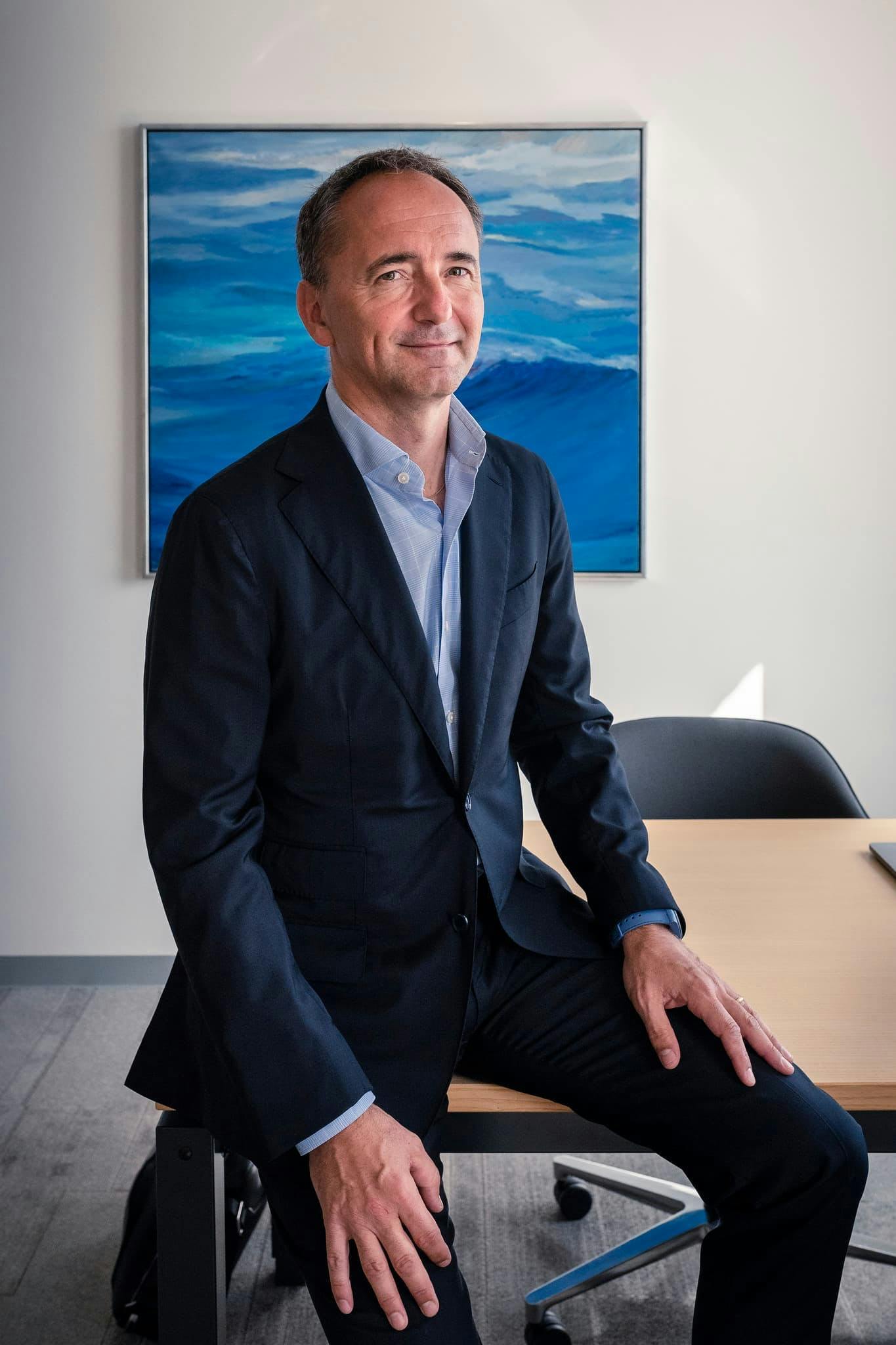Jim Hagemann Snabe on why we need startups, corporates and tech to shape a better future
n a sunny summer’s day last August, we sat down to chat with one of Europe’s leading industrialists, Jim Hagemann Snabe. Given Jim’s wealth of experience advising global corporations across various industries, we were keen on hearing his thoughts on the future of business. For Jim, who’s the Chairman of Maersk and Siemens and the former co-CEO of SAP, solving the world’s problems comes down to creativity, leadership and big companies working with startups.
In his office in Copenhagen at the headquarters of the global transportation and logistics company, Maersk, Jim is explaining what motivates him to do what he does each day. Much of it roots back to a pivotal experience in his life over a decade ago.
Years ago Jim was in India for a few weeks as part of a training course aimed at understanding the true nature of globalization. “I spent time with some of the poorest and wealthiest people on the planet,” the 52-year-old Danish businessman says. “This experience taught me that the world has many problems and they can only be solved through responsible leadership and innovation.”
Not only is Jim the Chairman of Maersk and industrial manufacturing company Siemens, he’s also a member of the board of trustees at the World Economic Forum. He started his career in the 1990s at SAP before working his way up in the business software systems company to co-CEO from 2010-2014. Jim is additionally an adjunct professor at the Copenhagen Business School, a board member at financial services company Allianz Group and an advisor at VC fund Nordic Alpha Partners.
I decided I needed to contribute more to improving the state of the world.
“I came home from that trip and decided I needed to contribute more to improving the state of the world,” Jim says. After seeing people in India improve difficult situations even in the face of seemingly impossible hurdles, he learned that most problems can be solved with leadership.
Accordingly, he realized that if he could use his influence as board member to get SAP to contribute to solving some of the problems in the world, he’d have a much bigger impact. SAP subsequently began considering how they could do their part in improving people’s lives and making the world more sustainable.
Siemens also has aims to be even more purpose-driven and to accelerate the path they’re on, according to Jim. Among other things, this includes growing the company’s capabilities within wind power and intelligent energy networks to transform energy systems to become sustainable and more affordable.
Innovation networks
This is precisely where digital technologies and startups come into the picture. From ensuring inclusivity, to instant connection to global markets, Jim believes that if applied well, technology can solve all the problems in our world. “We’re at a tipping point,” he says, explaining that the path forward involves using tech as a tool to make significant improvements in society.
Meanwhile, unlike established giants, startups benefit from beginning with a blank slate. “I’d argue startups have the best and most creative ideas because they don’t have a legacy,” Jim says. “We need startups because they challenge the status quo, and if we really want to create a better world with tech, old assumptions need to be put to the test.”
The issue Jim sees though is that while startups have access to tech and creativity, they don’t typically have access to scale and thus have a tough time getting their products and services to those who need it. He believes the reason why many startups fail is because they don’t have access to scale, whereas large companies do.
Dream big dreams and care about the details that matter the most.
“If we combined the two – the great ideas that startups have, and access to scale through the large companies – we would create what I call innovation networks, where we’d simultaneously have unlimited creativity and unlimited scale,” he says.
In order to deliver on the UN’s 17 Global Goals for Sustainable Development, these innovation networks are necessary, according to Jim. Since the UN adopted a new set of Global Goals in 2015, including aims to end poverty, tackle climate change and fight inequality, it has called on us all to improve the place we call home.
Startups working with corporates
In order for startups to be able to scale, however, established corporations realize that innovating on their own limits their innovation capacity. Instead, they should be more open-minded when it comes to working and innovating with young companies. “I learned that at SAP,” Jim says. “SAP used to be a company that was closed-minded.”
Founded in Germany in 1972, SAP has over the past several years transformed to attract young companies with bright ideas, and drive innovation beyond its traditional boundaries and range of customers. One of their newest initiatives, SAP.iO Venture Studio, kicks off new ventures that make use of SAP’s data, customer relationships and technologies.
An initiative called Next 47 is another example of how a corporation is working collaboratively with young companies. Launched in 2016, Next 47 was set up by Siemens to “foster disruptive ideas more vigorously and accelerate the development of new technologies,” a company press release states. The name of the global venture firm which invests in entrepreneurs alludes to the fact that Siemens was founded in 1847.

Jim Hagemann Snabe in his office at Maersk in Copenhagen. Photo: Startup Guide
Taking risks and focusing on the details
But Jim’s approach to leadership doesn’t exactly align with what board members did in the past. “Traditionally, boards at established companies made sure that they were acting in a compliant way, reporting their earnings consistently and not taking too much risk,” Jim says. “New boards, however, ask themselves how they can ensure large companies are constantly reinventing themselves and are open to experimentation.”
A key aspect to Jim’s role as Chairman involves aiming for the next wave of success and prioritizing this over short term financial goals. He supports management when it comes to challenging assumptions and creating spaces in their companies that allow for innovation.
In Dreams and Details, a book Jim co-authored last year about how leaders need to think differently about leadership in light of a disruptive, digital future, he argues large companies should take risks from a position of financial strength. “They need to take these risks when things are going really well rather than when they’re in trouble – by then it might be too late,” Jim says.
We need startups because they challenge the status quo, and if we really want to create a better world with tech, old assumptions need to be put to the test.
In the context of startups, he explains, the fundamental principle of the book still fits: “big things happen when you have a big dream and purpose that can inspire people to unleash their full potential.” In other words, thinking about what your startup can become and what kind of impact you’ll have will go much farther than thinking about how you can sell a product out of your great idea.
The biggest advice Jim says he has for entrepreneurs is to “dream big dreams and care about the details that matter the most.” He adds that the startups which managed to scale globally were founded by entrepreneurs who were obsessed with the few details that really mattered.
Take Steve Jobs, for instance. User experience was one thing he’d spend obscene amounts of time on because he knew it was a key differentiator for Apple, Jim says. So spend a third of your time on each of the two or three things you insist on, because if you don’t “your dream will remain a dream.”
Luck, opportunities and creativity
With regards to his rich career, Jim insists it was “a journey of luck” to have been part of a successful company like SAP which gives its employees plenty of opportunities. “Don’t underestimate the importance of luck,” he says. After starting as a trainee at SAP in 1990, he took on more and more responsibilities and was still quite young when he began in a leadership role.
“My philosophy has always been to make sure someone else can do what you do,” he says. “Train them really well so that you are no longer needed and you can move on and learn new things. Because if you're the only one who knows how to do your current task, the likelihood you’ll be asked to do something else is slim.”
It’s equally important that young people create their own opportunities.
Another aspect to the changing world of work is that it’s brought with it new challenges particularly for young people. “Opportunities don’t come if we assume that you need to be employed by a big company,” he says. Although there’s nothing wrong with this, “it’s equally important that young people create their own opportunities.”
At Maersk headquarters, efforts are being made to attract younger people, including the recent opening up of a new digital innovation department leveraging AI and design thinking. The colleagues who work there actually sit in the offices where the oil business used to be, Jim explains. He believes in the future, the most valuable ‘oil’ will be human creativity.
Meanwhile, there have been talks at Siemens about selling kilowatt hours, even though the company has long since sold products like wind turbines. In a digital world, products are increasingly becoming the enabler of business, Jim says. “What’s valuable is not the product, but the impact the product has.”
But in order to be truly innovative, a business needs to have impact through scale, he insists. It’s therefore not enough for a startup to have a cool, creative idea. With the support of corporates, startups can scale and their great ideas can get out there. And along with the creation of businesses that address problems in the world that need solving, according to Jim, the future might just look brighter for us all.
See also: 'If you want to make a positive impact in the world, start a for-profit social enterprise'
All photo: Startup Guide
*This article was originally published on October 17th, 2018 and updated on December 11th, 2018.

